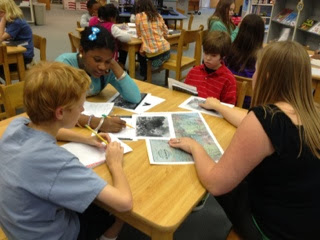(Guest post from media center intern Tisha Woo):
"Google.” “Wikipedia.” “WebPath Express.”
"Google.” “Wikipedia.” “WebPath Express.”
When asked how they typically find out information for a project in school, these are the responses I received from the fifth-graders in Ms. Roach's class. I would guess many students would answer similarly regardless of what school they attend or grade they are in. Finding quick answers on the Internet is widespread among both students and grown-ups!
These same fifth-graders spent time with me in the media center this week learning how to research the Westward Expansion using primary sources from the Library of Congress.The Library of Congress provides primary source sets of different topics in history, plus analysis guides and research tools.
As a group we first defined what primary sources are: information that comes directly from a time in history, created by people from that time. We then made guesses about the Westward Expansion by just thinking about the words “west” and “expand.” Finally, we analyzed together a painting from that time period, “American Progress.” We asked, What do we notice first? What people and objects do we see? What is happening in the painting? What might these things tell us about the Westward Expansion?
 Afterwards, students were divided into groups and cycled through several stations. Each station had a different primary source featuring a different people group from the Westward Expansion. These included women pioneers (an interview), homesteaders (a letter from a pioneer to his wife back East), Native Americans (a photograph of three warriors), African-Americans (an interview and a travel log), and others.
Afterwards, students were divided into groups and cycled through several stations. Each station had a different primary source featuring a different people group from the Westward Expansion. These included women pioneers (an interview), homesteaders (a letter from a pioneer to his wife back East), Native Americans (a photograph of three warriors), African-Americans (an interview and a travel log), and others.
 Afterwards, students were divided into groups and cycled through several stations. Each station had a different primary source featuring a different people group from the Westward Expansion. These included women pioneers (an interview), homesteaders (a letter from a pioneer to his wife back East), Native Americans (a photograph of three warriors), African-Americans (an interview and a travel log), and others.
Afterwards, students were divided into groups and cycled through several stations. Each station had a different primary source featuring a different people group from the Westward Expansion. These included women pioneers (an interview), homesteaders (a letter from a pioneer to his wife back East), Native Americans (a photograph of three warriors), African-Americans (an interview and a travel log), and others.
Students studied the primary source in their small groups, identified what they noticed, and looked for keywords, which they recorded on two-column research sheets. Students at the song sheet center could be heard putting the verses to their own tunes; students studying Native Americans wondered about why warriors were holding women’s hats and wearing plaid shirts; and students who read the interview with an African-American cowboys talked about who they thought “the Vigilantes” might be.
It was a challenging process for these students to learn history directly from these sources, but as we concluded our research, students shared what they enjoyed:
“The information came right from that time period.”
“You knew you were learning about a real person.”
“The sources were more reliable than what you can find searching Google.”
The students also concluded it would be beneficial to study other topics using primary sources. I enjoyed seeing their understandings about information and research grow through this experience!
 |
| Freewriting in our journals after concluding our research. |






No comments:
Post a Comment